Introduction
Paper-based, single use coffee cups are ubiquitous. They are used in work-place kitchens, cafes, cafeterias, fast food restaurants. The composition is paper or a cellulose fiber. While the base material seems perfect for recycling, its a true tragedy that single use coffee cups are in fact not recyclable. To prevent leaking, the interior surface is lined with a very thin plastic film which renders the cup a mixed material which in turn is not recyclable, contrary to most people’s expectations.
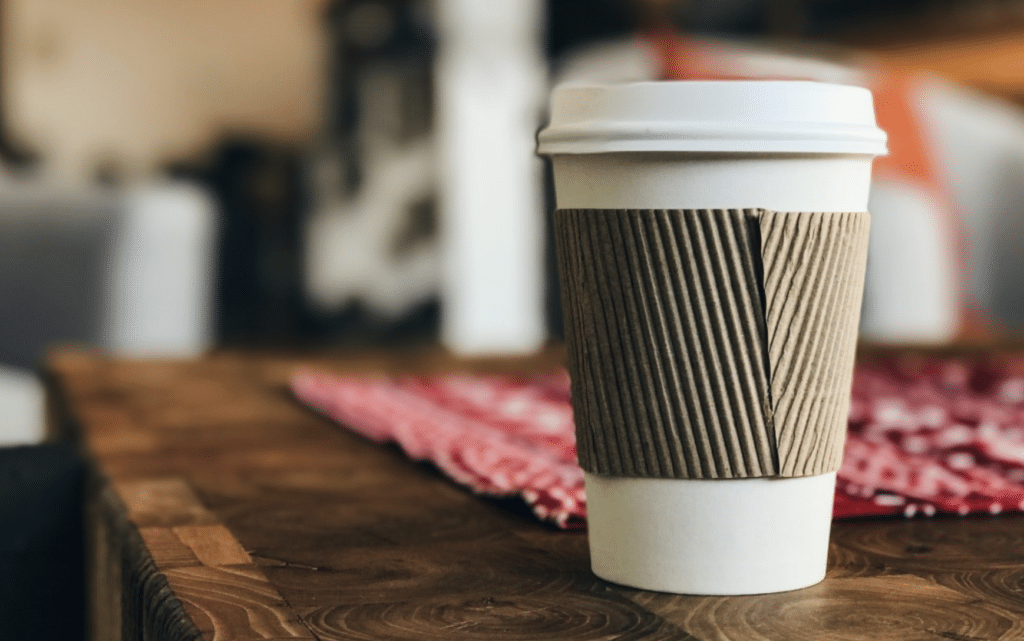
Inability to recycle a product can be offset by responsible sourcing for example from farmed trees. Making a product from a farmed tree means an initial carbon fixing step which draws carbon from the atmosphere so there’s a net zero carbon emission when it decomposes back into the atmosphere. But unless a vendor, whether its a retail supermarket or a coffee chain, has verified and communicates that its paper cups are from farmed trees or recycled paper, we’re going to assume that its from non-farmed trees.
The Ecoffee Cup is the Ecoffee Cup company’s answer to single-use cups
One company wants to address single use cups with its product. What is this product? Well, it’s basically … a cup. Like other cups, Ecoffee cups are … reusable. So what’s special? Well, these cups are pretty cool looking. They’re made to look like paper coffee cups with plastic lids and paper sleeve, but that’s where the similarities end.
Instead of paper, the cup is an upcycled, hard fiber derived from bamboo, corn starch, and resin, that makes it light, strong, and long-lasting. The lid and the heat sleeve is made of a different material: a food-grade silicone, which is heat resistant.
The Ecoffee Cup is supposed to be reused and if it breaks, or if any of its components break, it’s to be shipped back to the company for them to recycle it into a new Ecoffee cup. To clean your Ecoffee Cup, just wash it in warm soapy water and allow it to air dry. In short, we liked what we heard and wanted to experience for ourselves the product so we got our own Ecoffee cup.
Our experience getting an Ecoffee cup – ordering the cup
We went online to buy a cup. Buying the cup is quite simple. It’s available on the manufacturers website which is Ecoffeecup.com. There’s a lot of variations of colors. We picked a simple off-white with black lid and heat sleeve so it reminds us of a single use coffee cup as much as possible.
Then we checked out to pay for the cup and shipping. The company ships out of the UK, so the time to ship and arrive at your destination will depend on the efficiency of commerce between you and the warehouses. At the time we bought it, the cup was £9.95 plus shipping.
Shipping within the UK was £3.95 without tracking and £5.95 with tracking. Worldwide the shipping was a flat cost of £10.95. The world wide shipping fee is nice and simple, but also doubles the cost! So be prepared to pay a premium if you’re outside the UK. The shipping was very fast and the cup arrived within 5 days for us.
Silicone lid
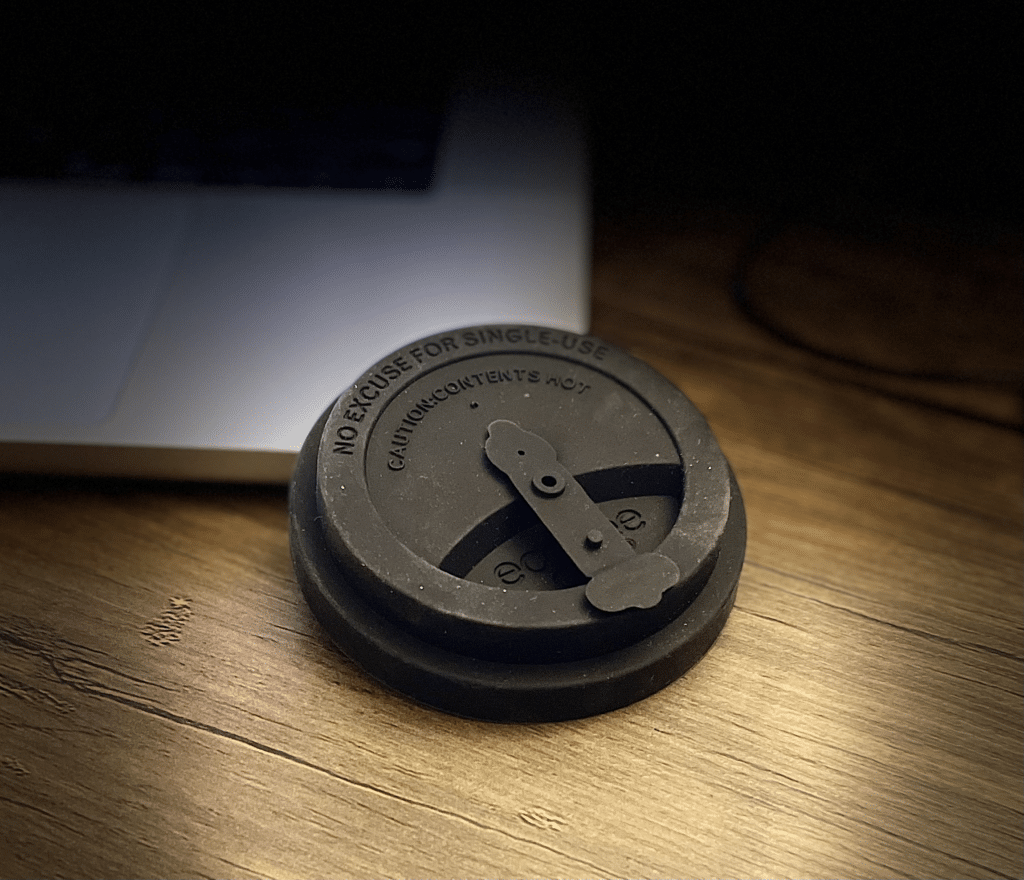
We noticed first that the cup came in a recycled paper box which was a nice touch. Inside the box the cup was already assembled. So we took it apart. The first thing we looked at was the lid. The lid is made of a soft silicone material, imprinted with the words “No Excuse for Single Use” on the top which internally rhymes and is very apt. There’s a hole for the steam and a silicone latch that closes over the hole to keep the liquids and heat inside. The lid is flexible and rubbery, so it has to be stretched and adjusted to get onto the cup. Once it’s on, it stays on quite well.
Heat sleeve
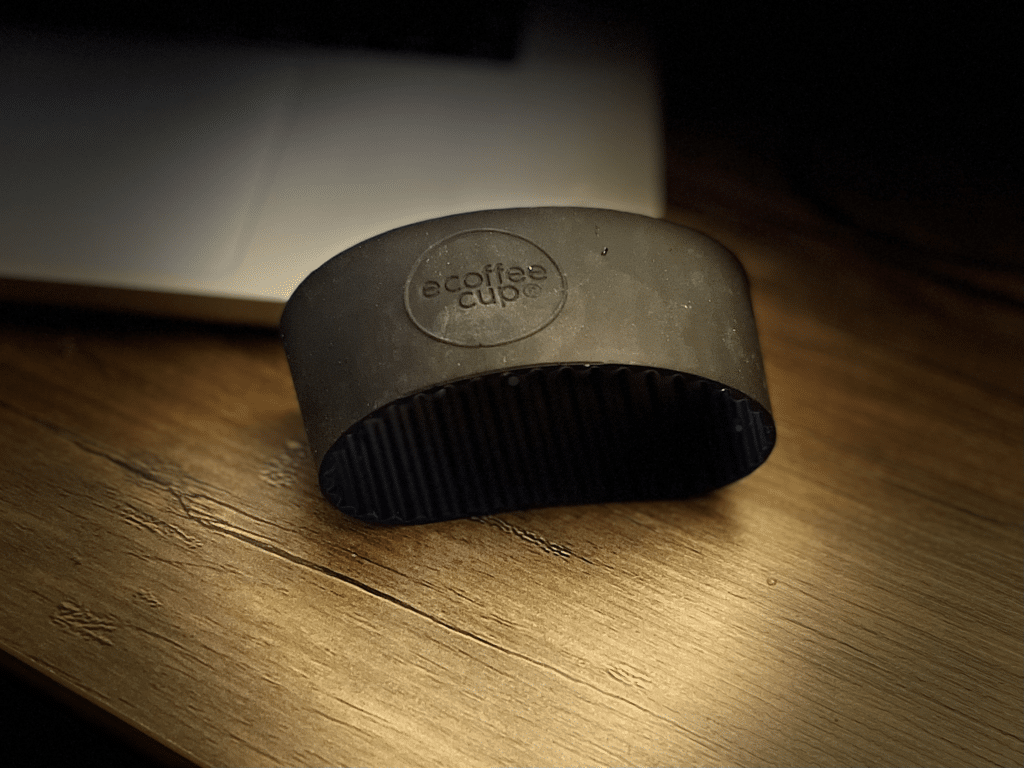
The second thing we looked at was the heat sleeve, which is also made of a soft silicone material, shaped like a cylinder that fits snugly around the tapered shape of the cup. The sleeve is thick enough that when the cup has hot fluids, it lets you hold the cup without your hand from getting too hot. The words “Ecoffee cup” are imprinted on the side of the sleeve. The heat sleeve is quite grippy yet slides on without much trouble and is good to hold. Interestingly the inside surface of the heat sleeve is very ridged. The ridging creates pockets of air between the sleeve and the cup when its slipped on. More on that later.
The cup
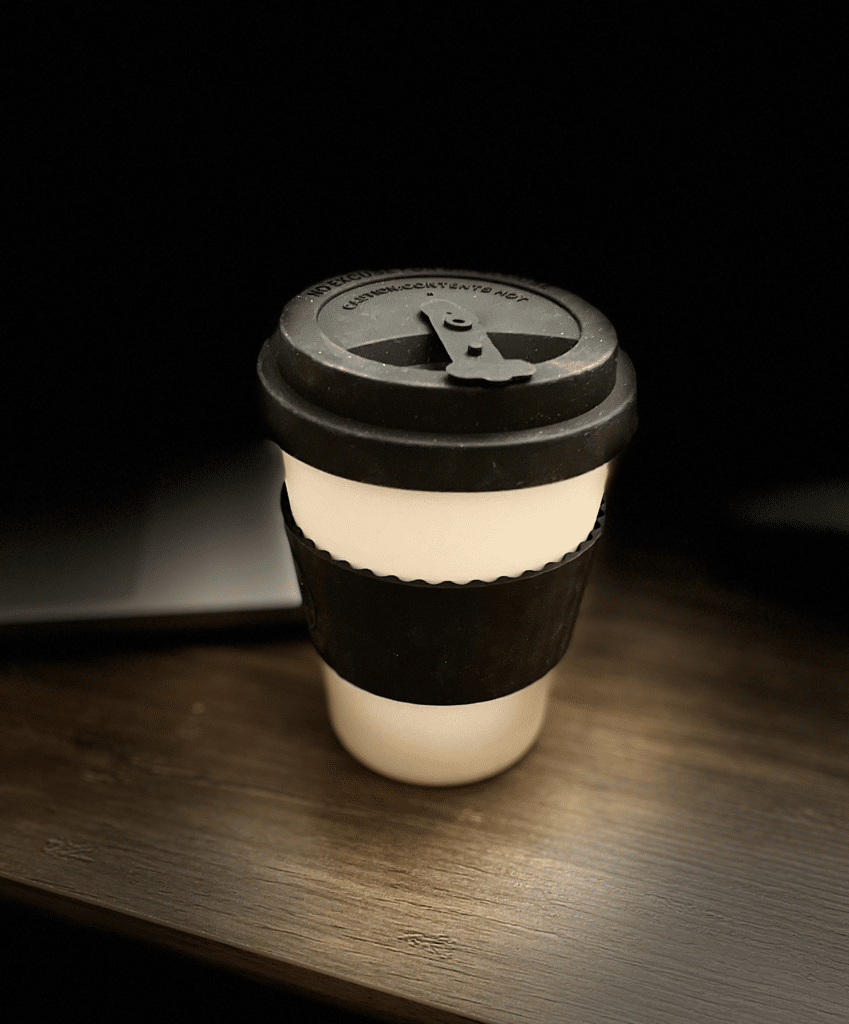
The cup itself is surprisingly hard and sturdy. It’s supposed to be derived from a bamboo fiber, bonded with resins. The result is something that feels like a hard plastic. It’s about the size of a normal, single-use coffee cup. When you use it you’ll feel like you’re just having a regular cup of coffee. We tried putting in very hot liquids into the cup.
Water at 88 degrees Celsius made the cup very hot, very uncomfortable to touch directly through the cup, and too hot to hold for long. This made it quite similar to a thick paper cup. It was necessary to hold it with the sleeve. The sleeve, fortunately, was thick, and ridged so as to add a bit of air between it and the cup. That small layer of air really cut down on the heat and then holding the cup with the sleeve was perfectly fine.
Drinking from the cup is a pleasant experience. The ridge is beveled with at least two surfaces we could see. It made the drinking very easy, with no dripping or other difficulties. The cup seemed to be excellently designed.
Summary of the Ecoffee cup
In total we really liked the cup for its aesthetics, its thoughtful functional construction, its eco–friendliness, and for the two essential accessories of the lid and heat sleeve. It’s also a wonderful reminder of the potential carbon emissions impact of single use coffee cups. Carrying around a ceramic mug accomplishes many of the same objectives of course. But carrying around an Ecoffee cup means also a quirky entry into a conversation about design, purpose, sustainability, and the carbon equation.
The Ecoffee cup is part of the zero waste trend
The Ecoffee cup is part of a trend of moving to zero-waste by avoiding single-use items. Think plastic bags, plastic trays, non-recyclable paper cups. By using an Ecoffee Cup, you would be helping to reduce the amount of waste going into landfill each year, reducing the harvesting of virgin forests, perhaps even promoting sustainable tree farms by spurring the single use cup producers to source more responsibly. With its unique design and commitment to sustainability, Ecoffee Cup is a great choice for those who care about the environment.
Using bamboo scores more points from us because its considered a “sustainable material“. Bamboo is a grass so when its harvested, it leaves behind the root which lets it grow again, unlike trees that need replanting. In fact in many places bamboo is considered pesky because it tends to spread and out-compete other flora so harvesting it is doing a favor to the ecosystem for its control of the spread of the grass.
Benefits Of Using Ecoffee Cups And Mugs
There are many benefits to using Ecoffee Cups and mugs. For one, they help to reduce environmental waste. Traditional coffee cups and mugs are often made from virgin forests and non-recyclable materials, which means they end up in landfill where they take up valuable space and emit carbon into the air. Ecoffee Cups and mugs, on the other hand, are made from sustainable materials and not meant to be discarded. This means they have a much smaller carbon footprint than traditional coffee cups and mugs.
There’s a hidden cost to coffee in form of single use coffee cups. You can see the cost in fact because the savings from not using a single use cup are passed onto consumers via discounts for customers who bring their reusable cups. Starbucks for example gives 10 cents to a customer who brings his or her own cup. You can read more about the details of “bring your own cup”.
Are Ecoffee Cups Safe?
Ecoffee cups are advertised as safe for both the environment and the user, but are they as safe as they claim to be? Bamboo is a pretty natural material. What we don’t know is the manufacturing process, likely a patented process or a trade secret, of the Ecoffee cup. But it doesn’t seem that there should be anything dangerous in bonding bamboo fibers into a cup.
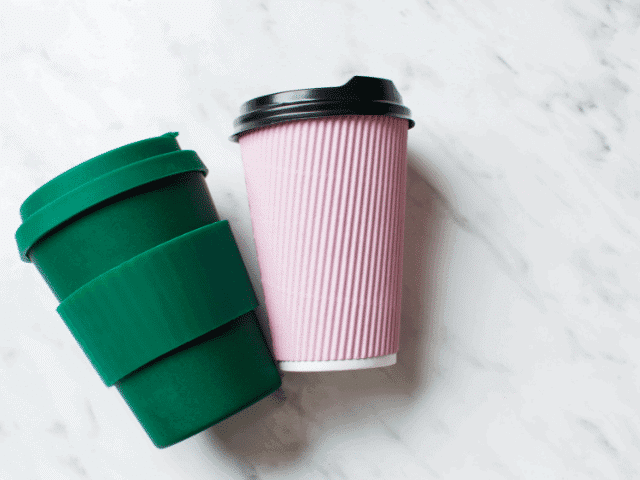
How Long Do Ecoffee Cups Last?
Most coffee cups are made from paper, which is coated with plastic to make them waterproof. These disposable coffee cups are only meant to be used once and then thrown away. In contrast, Ecoffee cups are made from a very durable bamboo-derived composite material.
This means that they can be used repeatedly, saving you money in the long run. How long do Ecoffee cups last? From what we see, with proper care, an Ecoffee cup should last indefinitely. That’s not to say that the cup won’t shatter if subjected to impact or stresses!
Wrapping Up
In conclusion, Ecoffee cups are a great alternative to disposable coffee cups. They are made from sustainable materials, save you money in the long run, and are safe for both the environment and the user. So if you’re looking for a more sustainable way to enjoy your coffee, consider switching to an Ecoffee cup!

Anne Lauer
Anna Lauer is a writer, gardener, and homesteader living in rural Wisconsin. She has written for Mother Earth News, Grit, and Hobby Farms magazines. Anna is writing a new book about growing your food for free and an ultimate guide to producing food at little to no cost. When she’s not writing or gardening, Anna enjoys spending time with her husband and two young daughters.
